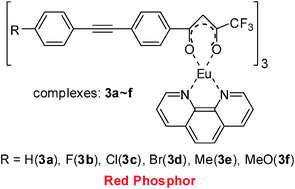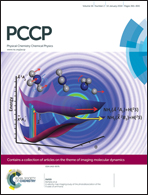Synthesis and photophysical properties of europium(iii)–β-diketonate complexes applied in LEDs†
Abstract
Six β-diketonate ligands were used to prepare the corresponding antenna europium(III) ternary complexes using 1,10-phenanthroline as an ancillary ligand. All the complexes exhibited high decomposition temperatures. Photophysical properties such as FT-IR spectra, UV-Vis absorption spectra, excitation and emission spectra, relative luminescent intensity ratios, luminescence decay curves and quantum yields based on the complexes were systematically studied and compared with each other. The energy-transfer mechanism was proposed as a ligand-sensitized luminescence process. Bright red light-emitting diodes (LEDs) were then fabricated by coating the complexes onto 395 nm-emitting InGaN chips. The light emission from the InGaN chips could be completely absorbed in the spectra of LEDs. The Commission International de I'Eclairage (CIE) chromaticity coordinates are close to the National Television Standard Committee (NTSC) standard value for the red color. All these findings indicate that these Eu(III) complexes are promising red phosphors for fabrication of near UV-based white LEDs.


 Please wait while we load your content...
Please wait while we load your content...